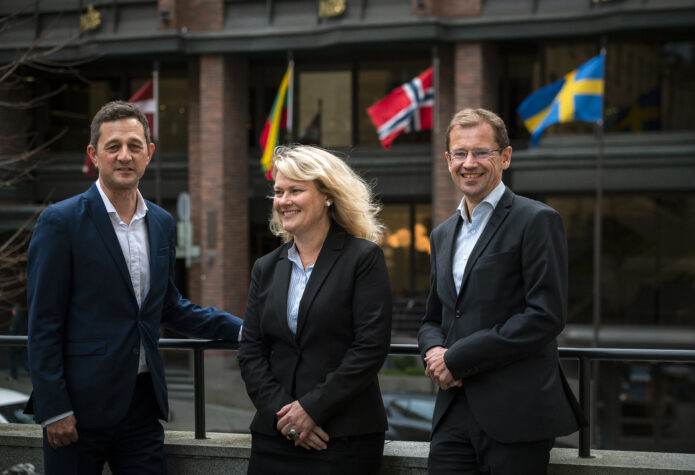10 years in the sustainable bond market: connecting investments to environmental impact

This year, NIB marks its 10th anniversary as a green bond issuer. Since the launch of NIB’s Environmental Bonds (NEBs) in 2011, the Bank has issued EUR 5.8 billion in environmental bonds and financed over 130 sustainable projects with its proceeds. To celebrate the anniversary, we look back at the decade in the eyes of some of those who played a part in the journey.
NIB has an explicit mandate from its Nordic and Baltic owners to promote productivity gains and environmentally beneficial projects. Aiming to attract investors focused on environmentally sound investments, the Bank established the NIB Environmental Bond framework (NEB Framework) in 2011.
Since then, NIB has issued NEBs every year, with 26 transactions in total. The Bank’s expertise in assessing and financing projects that benefit the environment was crucial for the successful launch.
Building on the environmental mandate
“Ten years ago, we and many investors were still a bit sceptical about the idea of a green bond; investments were about risk and return. But we convinced ourselves that a trend has started – impact is important,” says Jens Hellerup, Head of Funding & Investor Relations at NIB, explaining how it all started.
“NIB already had the building blocks: we had been lending to environmental projects, we had the expertise of environmental analysts, and we had an established process to assess and report on the impact. All this led to the NEB Framework, and the first NEB was issued in November 2011.”
This shift from only risk and return to broader impact was soon picked up by investors, who identified the need to have a long-term vision for their investments.
“We think that being long-term sustainable equals being long-term profitable, therefore, we have invested over SEK 37 billion in sustainable bonds. NIB is a very important issuer in the Nordic and Baltic region, helping us to face not only the current, but also those future problems we have with the environment,” says Ola Björkman, Portfolio Manager of Swedbank Robur, a company that has been actively investing in NEBs since they have been launched.
Channelling the funds to transformative projects
Investors such as Swedbank Robur need to be sure that their money is put in good use to achieve their sustainability targets. In accordance with the NEB Framework, the proceeds of NEBs are allocated only to prudently selected projects that benefit the environment in NIB’s member countries.
During the decade, NEBs helped to finance over a hundred sustainable projects. The first borrower to receive funding from the NEB proceeds was a Danish utility company, Ørsted A/S, for the construction of the Anholt offshore wind farm back in 2011.
“The project comprises 111 3.6 MW turbines and produces approximately 1,800 GWh of power per year, equivalent to the demand of 400,000 households,” says Ørsted’s Vice-President and Head of Treasury & Capital Planning Kasper Kiim Jensen, explaining the scope of the project.
“When commissioned in 2013, Anholt offshore wind farm was by far the largest wind energy project undertaken in Denmark and among the largest in the world. Anholt was a defining moment for the Danish energy sector, where offshore wind became a driver for change on an industrial scale.”
Thus far, renewable energy generation projects have received the highest share of NEB-financing (25.9%). Green building investments are not far behind, currently standing at 24.6% in terms of the share of all NEB-financed projects.
In the case of the latter, NIB’s cooperation with Sweden’s leading property developer Vasakronan AB has played a role to foster green construction in the region. “Getting the first loan from NIB was a milestone in our green funding. It really was a stamp of approval for our sustainability work,” says Anna Denell, Sustainability Director at Vasakronan.
Over the years, five Vasakronan’s projects were financed with NEB proceeds: Sergelhusen, Nya Kronan, and Frösunda buildings in Stockholm, Platinan in Gothenburg and Hubben in Uppsala. All these properties are certified under the LEED Platinum green building standard.
Transparency is key
The selection and reporting process was laid out in the NEB Framework back in 2011. The framework is aligned with core components of the Green Bond Principles and has a dark green Second Opinion from CICERO.
“To issue green bonds, investors expect a second party opinion on the greenness of the investments. A second party opinion is required to be listed on the stock exchanges and represents the quality stamp of the green bond market,” explains Harald Francke Lund, CEO of CICERO Shades of Green, a leading assurer for green investments. “NIB received a dark green rating – our highest rating, which highlights that the NEB Framework includes attributes that are crucially important for a low carbon and climate resilient future.”
According to Lena Korkea-aho, Senior Environmental Analyst at NIB, transparency is key to good impact reporting: “We report on the impact for each project financed by our environmental bonds, and all our impact data as well as information on the methodology we apply are easily accessible. Examples of what we report on include added renewable energy, avoided greenhouse emissions, and reduced pollutant discharges to surface waters, such as the Baltic Sea.”
Finding new ways to address water related challenges
The Baltic Sea has been affected by eutrophication due to the high levels of nitrogen and phosphorus discharge that result in excessive plant and algae growth. To tackle this, in 2019, under the NEB framework, NIB also started issuing Nordic-Baltic Blue Bonds – the first of its kind in Europe.
These bonds are specifically aimed at investors that are conscious of the challenges facing water resources. Thus far, the Bank has issued EUR 335 million in Nordic-Baltic Blue Bonds, which financed 14 wastewater treatment, prevention of water pollution and water-related climate change adaptation projects.
One of them is the Nya Slussen project in Stockholm, where NEB is financing clean transport solutions at the Slussen traffic hub, and NIB’s Blue Bond supports the redevelopment of the Slussen water locks. “The redevelopment of Nya Slussen is helping us to be more prepared for extreme weather conditions and climate change in the future, such as higher water levels,” says Ola Björkman, who has seen the development through his own eyes as a Stockholmer.
As for the other capital cities in the region, the Nordic-Baltic Blue Bonds also finance water infrastructure improvements in Tallinn and Helsinki. For the latter, the bonds support the construction of the Blominmäki wastewater treatment plant.
“In Helsinki, the population is constantly increasing, and we need treatment capacity to accommodate new people. Still, one of the biggest problems in the Baltic Sea is the nutrient loads, and the new plant is very efficient when it comes to the removal of nitrogen and phosphorus load – we can remove more nutrients than before,” says Tommi Fred, Head of Service of Water Supply Management at HSY, Helsinki Region Environmental Services Authority.

Guiding the developments in the sustainable bond market
Bringing one’s own ideas to the table becomes easier when similar experiences are shared. During the decade, NIB has been actively involved in initiatives aimed to promote the integrity, transparency and development of the green bond market, among which include Nasdaq’s Sustainable Bond Network or the Network for Greening the Financial System.
“One of the most prominent initiatives in the market has been the establishment of the Green Bond Principles in 2014,” says Angela Brusas, Funding & Investor Relations Director at NIB.
Since then, the initiative has grown to cover not only green, but also the Social Bond Principles, the Sustainability Bond Guidelines, and the Sustainability-Linked Bond Principles – all of which are referred to as the “Principles” that provide the leading framework for issuers and investors.
“For NIB, it has been important to be at the forefront, supporting the efforts in growing the sustainable bond market while maintaining integrity as its cornerstone. We consider the work accomplished within the Principles as ground-breaking, and we are happy to be able to contribute to the initiatives by being part of the Executive Committee and the various working groups,” adds Angela Brusas.
According to Jens Hellerup, further developments in the market are imminent, and NIB is prepared to continue playing its part.
“Ten years in, the sustainable bond market feels like a lifetime. The market is developing rapidly, and we are ready to develop together with it. While doing so, we must build on the foundation of integrity, which guides the sustainable transformation and allows us to build trust.”
“As we celebrate the anniversary of NIB Environmental Bonds, we thank our investors, our lending clients, and other stakeholders for trusting us ten years ago. The journey is just beginning, and we are excited for the future,” concludes Jens Hellerup.
| NIB Environmental Bonds | 2011–ytd 2021 |
|---|---|
| Issuance: | EUR 5.8 billion |
| Transactions: | 26 NEBs (24 environmental, 2 blue) |
| Currencies: | 7 currencies (ZAR, SEK, BRL, EUR, USD, INR, NOK) |
| Projects financed: | 131 (117 environmental bond, 14 blue bond) |
| NEB Framework: | CICERO dark green Second Opinion |